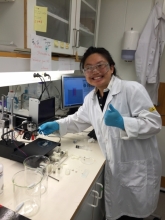
University:
Major:
Site Abroad:
Mentor(s):
Faculty Sponsor(s):
Faculty Sponsor's Department:
Project Title:
Project Description:
A considerable portion of medical implant surgeries fail due to bacterial infection, and the ensuing suppression or replacement procedure is painful and expensive. Coating the implant with antimicrobial material is among many solutions, and a biocompatible candidate is Pluronic F127. We have investigated the attachment of common perpetrator Staphylococcus epidermidis, onto the surface of acrylate-modified Pluronic F127 (MF127). For comparison, we assessed acrylate-modified Pluronic P123 (MP123); the untreated glass surface of a cover slip was our positive control. Both surfactants were hydrated to obtain a hexagonal H1 liquid crystalline phase (55% solution mass water, 45% MP123; 27% water, 73% MF127) then UV-crosslinked. Characterization using swelling and contact-angle measurements at full hydration (CAM) show that all samples are hydrophilic, and that MF127 (3.652% swell; 19.325±1.813° CAM) is more hydrophilic than MP123 (1.058% swell, 37.009±2.820° CAM) and glass (~67.5° CAM). Biomaterials were soaked in bacterial suspension (0.6 OD; 108 bacteria/mL). We visualized bacterial attachment at 24±3 hours post-contact, using fluorescence microscopy and nucleic acid staining (LIVE/DEAD BacLight Bacterial Viability Kit, Invitrogen). Statistical image analysis using ImageJ yielded percent bacterial coverage of the images: averages of 0.953 for positive controls, 0.558 for MP123, and 0.299 for MF127. Preliminary exploration of 3D-printing the biomaterials, rather than manual extrusion, yielded averages of 1.313 for positive controls, 0.861 for manually casted MP123, and 0.815 for 3D-printed MP123. We have observed reduced S. epidermidis attachment onto MF127 compared to MP123 and to glass. This result potentiates (M)F127 biomaterials as antimicrobial coatings for medical implants, facilitating a decrease in post-operative complications.
